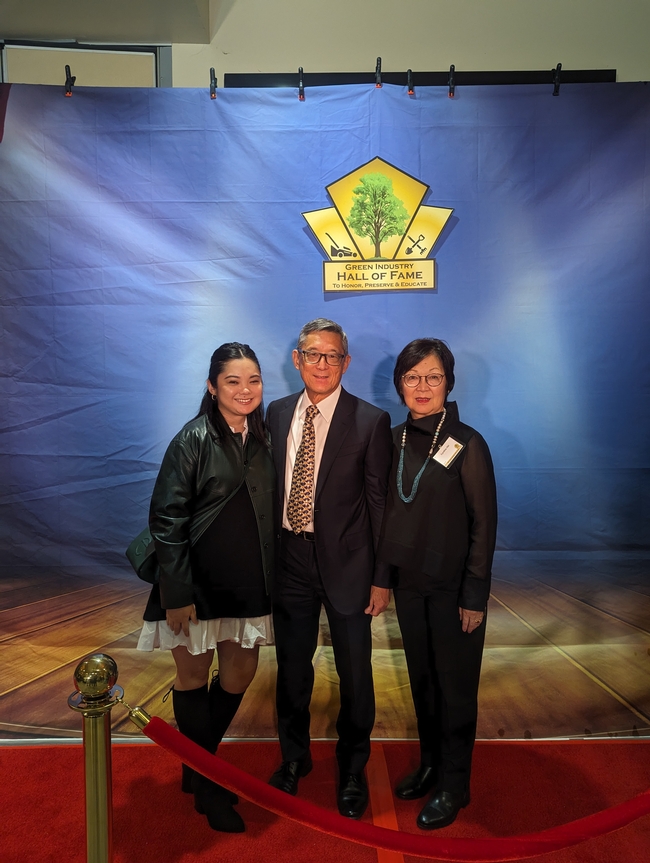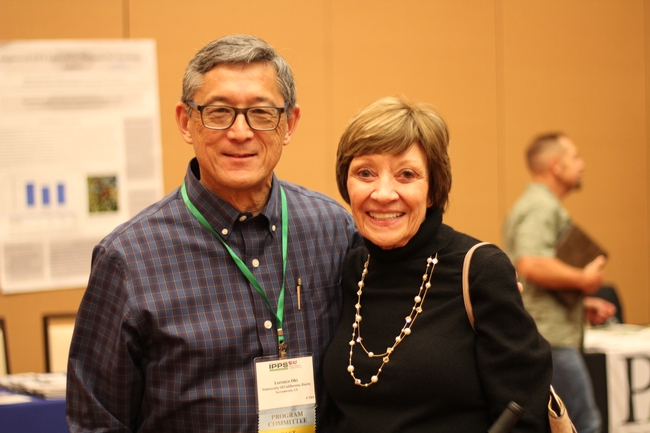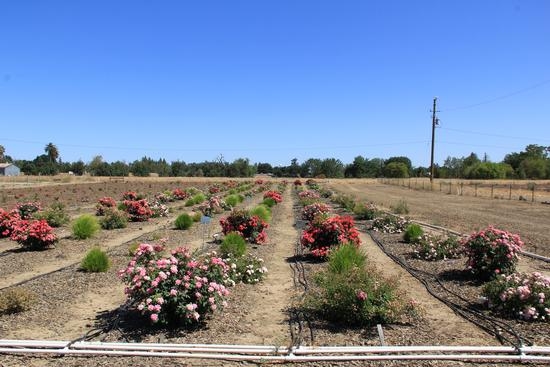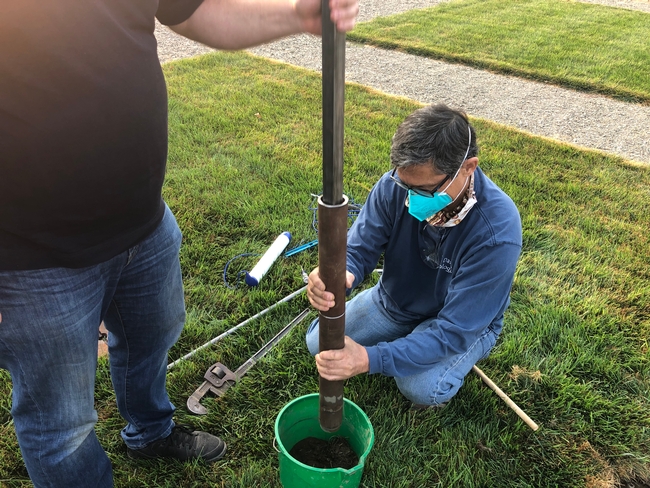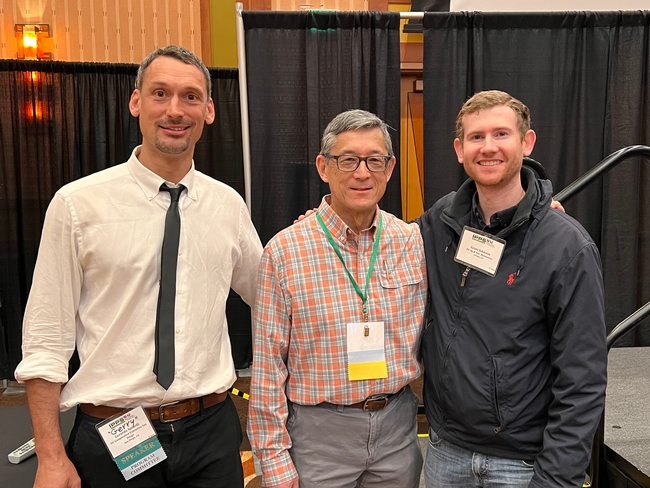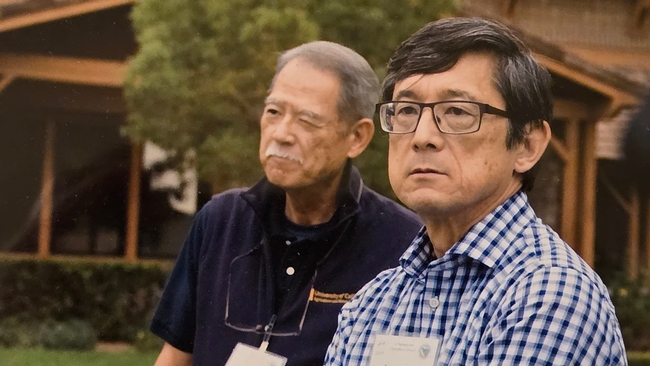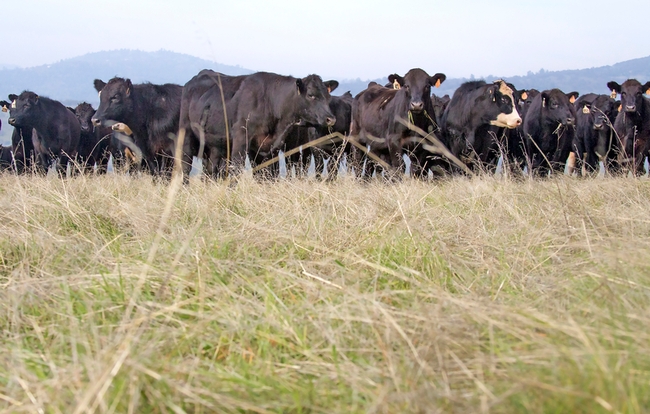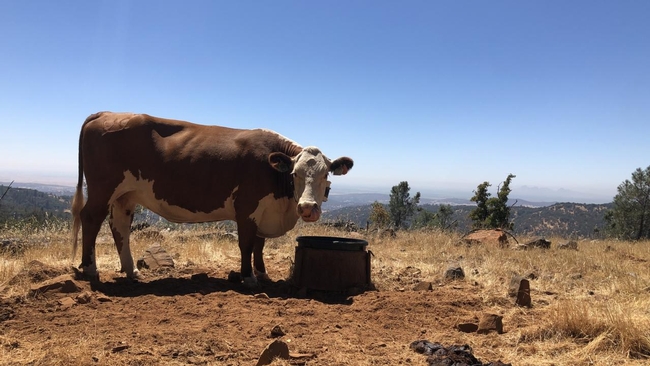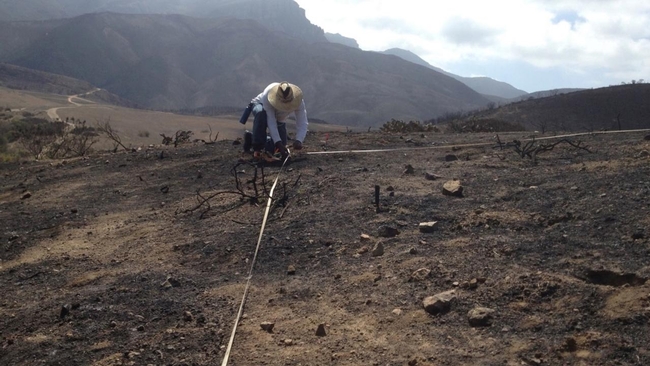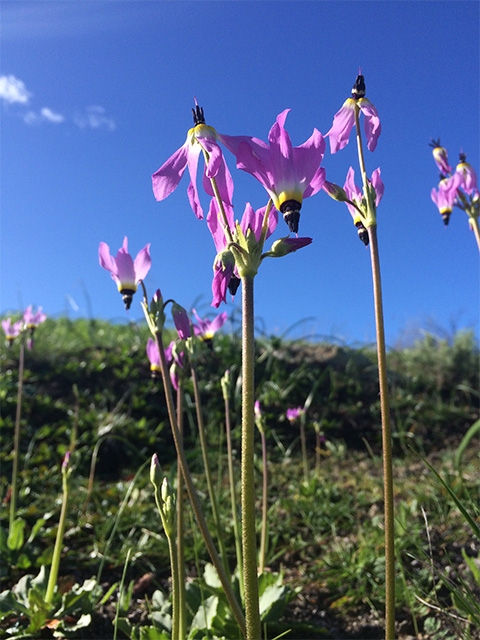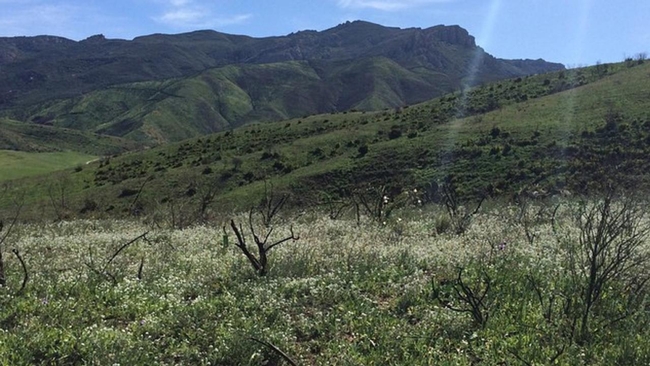Posts Tagged: uc davis
Diagnosing herbicide problems takes detective work
Field day offers examples, tips for solving the mystery
A grower applies an herbicide to his tomato plants, or thinks a neighbor's treatment is drifting over her almond trees. A short time later, the leaves start to bleach or shrivel. Was it the herbicide? Or maybe water stress? Soil nutrients? Perhaps an insect?
Figuring out the causes of crop problems takes detective work, and like solving any mystery, it starts with knowing the signs, gathering evidence and asking questions.
The Diagnosing Herbicide Symptoms field day at UC Davis was an opportunity to see, up close, the shriveled cotton, scorched corn and dying sunflowers that can result when herbicides are applied incorrectly. Using the right herbicide – in the right proportion, at the right time and in the right field – can make the difference between a thriving crop and a financial loss.
A top take-away to avoid problems: “Don't do stuff at night!” laughed Becky Wheeler-Dykes, a UC Cooperative Extension farm advisor attending the June 26 event to better serve growers in Glenn, Tehama and Colusa counties. “The packages look the same. People grab the wrong jug.” And then, disaster.
Instructors were Brad Hanson, professor of Cooperative Extension; and Kassim Al-Khatib, the Melvin D. Androus endowed professor for weed science; both in the Department of Plant Sciences. They were joined by John Roncoroni, a Cooperative Extension emeritus farm advisor rooted in the department's weed science program. Attendees were a mixture of people from agriculture, industry, government officials, university researchers and Cooperative Extension advisors. The event was hosted by the Weed Research and Information Center, based in the Department of Plant Sciences.
Out in a field west of campus, visitors could see the progression of damage, from control plots with green and healthy crops to plants that looked sadder as herbicide concentrations increased. Visitors could see the patterns of damage for common foliar chemicals such as glyphosate, paraquat, and 2,4-D, as well as soil-applied herbicides from several chemical classes.
“There's a lot of detective work,” said Stephen Chang, a master's student in Hanson's lab aiming for a career in Cooperative Extension. “For example, the company that makes the herbicide says there shouldn't be a problem, but the grower says, there is a problem. This course helps with developing the skills to figure out what happened.”
It might not be the herbicide at all
Detective work and problem-solving frame the approach, Hanson explained. The cause of crop damage can be simple or complex. Like a good mystery, what appears to be a clue can turn out to be a red herring. Professionals need to draw on their inner Sherlock Holmes to observe and document symptoms, look for patterns in the plants and in the field, ask questions, gather information about the larger environment and collect samples.
An herbicidal Agatha Christie would then suggest: What if it's not herbicide damage at all? Participants learned to consider the possibility of insects, pathogens and viruses, as well as problems with water, nutrients, soil condition and even root damage from cultivation practices.
Hanson recalled puzzling over symptoms he found in an orchard. The culprit? “A leaking natural gas line,” he said.
More resources for herbicide issues
Participants also heard from Molly Mathews, deputy agriculture commissioner from Yolo County, on how a field investigation is conducted. Lawyer Robert Davies, of Donahue Davies LLP in Folsom, outlined the basics of what happens when there are lawsuits related to crop damage from herbicide drift.
The Diagnosing Herbicide Symptoms field day is part of a larger program of education and outreach offered through the Weed RIC, said director Julia Stover-Blackburn. It was the first time the event has been offered since the COVID-19 pandemic, she added.
- For more information about field days and resources, visit the Weed RIC webpage.
- For a thorough discussion of herbicide symptoms, visit this page overseen by Al-Khatib and sponsored by University of California Agriculture and Natural Resources.
- This online course follows an earlier version of the Diagnosing Herbicide Symptoms field program.
This story was originally published on the UC Davis Department of Plant Sciences website.
Postharvest Center: New research focus and outreach
Still providing the world with top-notch information
UC Davis has been a leading source of information for people handling, packaging and transporting crops since the beginnings of the Postharvest Research and Extension Center in 1979. Now, the center is strengthening its focus on the needs of industry, offering fresh courses, weaving strategic partnerships and expanding into digital media, all while building up its research capacity to better serve the needs of the produce industry.
“We're asking people in the industry, ‘How can we support you? How can we better listen to you?' We want people to know we're not disconnected know-it-alls,” said new center co-director Bárbara Blanco-Ulate, an associate professor in the UC Davis Department of Plant Sciences. “We're getting more faculty involvement, people with expertise in related fields such as quality engineering and safety, as well as bringing in emeriti faculty and people from around California. We're forming partnerships with organizations around the world, and we've opened up to people from other institutions around the country.”
“The larger the network, the more things we can do,” added fellow co-director Irwin R. Donis-Gonzalez, an associate professor of UC Cooperative Extension in the Department of Biological and Agricultural Engineering.
The foundation: Expanded research
The new co-directors will beef up the center's applied science component with the hiring of a research specialist. They aim to provide new information that can be used industry-wide as companies explore new ways to handle and store fresh produce.
“We're building the capacity to respond to industry requests for research,” Blanco-Ulate said.
New courses, national reach
Their first workshop, held recently, demonstrates the center's renewed vision and commitment to broad networking: The Agricultural Water Systems Workshop addressed current concerns around water management and risks to food safety. Partners in the course included the Western Growers Association, the University of Arizona, the University of Florida and Salinas-based Taylor Fresh Foods, Inc.
Courses given over the past several years that have been recorded will be posted to the center's new, online video library and to the center's YouTube channel.
“People can watch those courses for free,” Blanco-Ulate said. In addition, new courses will be offered in-person and hybrid.
The co-directors are working with the University of California to offer continuing and professional education credits to course participants.
Online resources – many for free!
The center's website features a database with scores of free product fact sheets, which are downloaded by users around the world. The fact sheets are so highly regarded that they are considered expert evidence in legal proceedings, Blanco-Ulate said. Visitors to the website can also find links to research papers published by UC Davis faculty, including seminal works by Adel Kader, who founded the center.
Books are offered through the center's online bookstore and include titles through UC Agriculture and Natural Resources. Ten new titles are being planned, including topic-specific updates taken from previous classics.
Debunking myths: Ethylene
A new newsletter deals with a new problem: Misinformation about food and food handling that spreads through social media. One example is the use of ethylene to ripen produce such as bananas, so that they can be safely stored until ready for the consumer.
“Ethylene is safe for humans and does not leave any harmful residue on produce,” Donis-Gonzalez wrote in the center's latest newsletter. Even better news, he added: The levels of ethylene used on food are a tiny fraction of the concentrations that would be needed to create an explosion, one of the false alarms being raised in social media.
Evolving with the times
After 47 years of service, these and more updates will keep the center at the forefront of an evolving postharvest world. The top goal: Meet the needs of agriculturalists, industry and consumers.
“We are adapting to new needs, with both the resources and the workshop we're offering,” Donis-Gonzalez said.
“As a land-grant institution, we take our outreach mission seriously,” Blanco-Ulate added.
Related links
More about the UC Davis Postharvest Research and Extension Center.
This story first appeared on the UC Davis Department of Plant Sciences site.
Green Hall of Famer Oki retires after 29-year UC career
UCCE specialist's research prevents water pollution, reduces water use
When interviewed to become a University of California Cooperative Extension specialist in environmental horticulture, Lorence “Loren” Oki was asked what kind of research he wanted to conduct.
In response, he showed the hiring committee a photo of a residential gutter. “Water is a big concern, and I found very little research on runoff from homes,” said Oki, explaining that studying residential runoff is what “started his career” with UC Agriculture and Natural Resources back in 2002.
Although he remains active supporting growers and advising industry leaders, Oki retired from UC ANR in July 2023. Before joining ANR, Oki worked as a researcher for UC Davis' Department of Environmental Horticulture studying greenhouse irrigation in 1994, bringing his total time with the University of California to 29 years.
Oki, professor emeritus of Cooperative Extension at UC Davis, led many research projects that advanced the green industry which includes landscapes, nurseries and floriculture.
“Loren is the epitome of a specialist,” said Darren Haver, UC ANR's Research and Extension Center system director, who has worked with Oki for more than 20 years on projects that have significantly improved urban water quality and water conservation efforts across California.
Research influences pesticide management statewide
With a $3 million grant funding a statewide study, Oki and Haver set out to characterize runoff from residential sources over a five-year period. They determined the volume of irrigation runoff from residential land use, as well as the pollutants in the runoff.
Oki and Haver, co-principal investigators, along with researchers from UC Davis and UC Riverside, discovered that the degradation products of the insecticide fipronil – commonly found in runoff water – were more toxic than its parent compound. The study led to an investigation of human pathogens and pathogen indicators in residential runoff, the first of its kind.
Another contribution was the early detection of a new pesticide used for ant control, enabling strategies to be put in place to prevent it from reaching local streams and creeks. Oki and Haver's work also persuaded the California Department of Pesticide Regulation to change pesticide labels to minimize the chances of pesticides moving off target during irrigation and rain events.
These changes included preventing pesticide application before predicted rain and preventing irrigation after applications, keeping pesticides from impervious surfaces, and restricting applications on lawns and landscape beds within two feet of impervious surfaces and others.
Plant trials expand beyond California
Oki was also the principal investigator of the Climate-Ready Landscape Plants project, which may be the largest irrigation trial in the western U.S., and the UC Plant Landscape Irrigation Trials, the California component of that project. The UCPLIT trials originated in 2004 at UC Davis as a research project by Karrie Reid, retired UCCE environmental horticulture advisor for San Joaquin County, while she was pursuing her master's degree. In 2017, the irrigation trials were duplicated at the South Coast Research and Extension Center.
These projects evaluate landscape plants under varying irrigation levels to determine their optimal performance in regions requiring supplemental summer water. Throughout the trial, Oki identified many landscape plants, including rose cultivars, that remain aesthetically pleasing with little water.
Today, the trials have expanded beyond California as the Climate-Ready Landscape Plants Project at Oregon State University, University of Washington, University of Arizona and Utah State University.
Growing up in the nursery industry
In 2017, Oki obtained tenure, allowing him to expand his professional responsibilities to include production horticulture, specifically greenhouses and nurseries, an industry he was extremely familiar with. “I come from a nursery family,” Oki explained. “My grandfather started Oki Nursery in the early 1900s.”
During World War II, Oki's family was incarcerated in the Poston Relocation Center in Arizona and lost their homes and property. When they were released, they returned to the nursery industry to rebuild their lives. “After World War II, my father and uncle got more involved with my grandfather's work,” he said.
The Oki family played an instrumental role in technological development for nurseries in general. Oki Nursery, which was located in Sacramento, worked closely with IBM and was the first to use a computerized system in the industry.
Oki developed computerized scheduling for the bedding plants, poinsettias, chrysanthemums, bulbs and other crops. He developed a method to calculate the cost of any crop grown by the nursery at any point in the crop cycle and computerized greenhouse environmental and irrigation controls. This may not sound impressive now, but that was in the 1980s.
“My father was known for being progressive and he also knew everyone at UC Davis,” said Oki. “He wanted to work with anyone who had an interest in doing something good for nurseries.”
Inducted into Green Industry Hall of Fame
In the 1950s, Oki Nursery partnered with researchers from UC Davis' agricultural engineering program and developed the overhead sprinklers commonly used in nurseries today. Until the 1980s, Oki Nursery was the largest nursery in Northern California. Before it shut down in 1993, Oki worked in the family business as a greenhouse manager when runoff became a growing concern.
“I remember getting served with a notice by the Regional Water Quality Control Board stating that we needed to prevent runoff because it was polluted with nitrate fertilizer, which was common in the nursery industry,” Oki said.
One of those efforts focused on using controlled-release fertilizer instead of applying fertilizer via irrigation as a liquid feed. “What we learned is that if we converted nurseries to controlled-release fertilizer, we could reduce the nitrate runoff,” he said. While a member of the Oki Lab, Bruno Pitton earned his Ph.D. studying nursery hydrology and the fate of nitrogen fertilizers in container crop production adding to the information on runoff and nitrate management. Pitton is now the environmental horticulture advisor for Placer and Nevada counties.
In 2023, Oki was inducted into the Green Industry Hall of Fame, which recognizes individuals with a minimum of 20 years in the landscape, nursery or floriculture industry and who have made significant contributions to the field.
Having grown up in the industry, Oki said that his father taught him to never be afraid to try new things. “If you think you have an idea that might work, do the best you can to make it work. If it doesn't work out, then it doesn't work out. And that's OK,” he said.
Revitalizing space for greater impact
This mentality encouraged Oki whenever tackling new tasks, like rebranding the California Ornamental Research Federation, a space for education and collaboration, as UC Nursery and Floriculture Alliance.
In 2009, Oki and David Fujino, executive director of the California Center for Urban Horticulture, became co-directors of CORF, which catered to the cut flower industry. At that time, Oki and Fujino realized that nurseries generated much greater revenue in the state than cut flowers.
“It was a strategic decision to change CORF to UCNFA, which included floriculture and nurseries in the name,” Fujino said. Combined, nurseries and floriculture have consistently placed in the top five agricultural commodities in the state.
When reflecting on their partnership, Fujino said that working with Oki was a “natural fit.” “I couldn't have asked for a better partner, a better colleague and, ultimately, a better friend to have my back and work side by side,” he added.
Since UCNFA's launch, the two have worked to maintain the group's impact by hosting “Ask your Advisor” webinars to connect advisors to growers, as well as co-hosting large-scale events such as the annual conference for the International Plant Propagators' Society — an organization focused on greenhouse and nursery production education — for the Western Region, which Oki's father helped establish in the 1960s.
Encouraging a return to education
Gerry Spinelli, UC Cooperative Extension production horticulture advisor for San Diego County and member of UCNFA's administrative committee, described those who have learned from Oki as his sons and daughters. “When I meet someone that's learned from Loren or worked with him, that person instantly becomes my friend. That's the kind of effect Loren has on us,” Spinelli said.
Grant Johnson, UC Cooperative Extension urban agricultural technology advisor for Los Angeles and Orange counties, credits Oki for his master's degree in horticulture from UC Davis.
“Loren gave me a lot of direction as far as career choices and research interests. He instilled in me a dedication to life-long learning, just like he continues to do,” said Johnson. Before Oki became his professor, Johnson worked with Oki as a staff research associate at the South Coast Research and Extension Center in Irvine.
Another influential person in Oki's life is John Kabashima, emeritus environmental horticulture advisor for UCCE Orange and Los Angeles counties and fellow Green Hall of Fame inductee. Like Oki, Kabashima grew up in the nursery industry.
Oki, who earned a bachelor's degree in ornamental horticulture from Cal Poly San Luis Obispo and a master's degree in plant science from UC Riverside, decided to pursue a Ph.D. in ecology at UC Davis with Kabashima's encouragement.
While Oki was still working in his family's business, Kabashima said that Oki relied on UC ANR researchers for scientific information and felt like Oki wanted to be one of them. “I told him that he's a good nursery guy, but he's a better scientist,” said Kabashima. “His heart is in science.”
The two began working together as soon as Oki became a graduate student and have been colleagues and friends for nearly 40 years. “My favorite response from Loren whenever people ask him a question is, ‘It depends,'” Kabashima said. “It always leads to people opening up and giving more context. That's what Loren does, he gets you to think.”
Understanding cattle grazing personalities may foster sustainable rangelands
Matching herds to landscape can support animal growth and ecological needs
Not all cattle are the same when it comes to grazing. Some like to wander while others prefer to stay close to water and rest areas.
Recognizing those personality differences could help ranchers select herds that best meet grazing needs on rangelands, leading to better animal health and environmental conditions, according to a new paper from the University of California, Davis, published in the journal Applied Animal Behaviour Science.
“Cattle can actually be beneficial for the rangelands,” said lead author Maggie Creamer, who recently earned her Ph.D. in animal behavior at UC Davis. “Vegetation in rangelands actually need these kinds of disturbances like grazing.”
Ranchers can add elements to the rangeland such as water, mineral supplements and fencing to influence where cattle graze, but little research has been done on how those efforts affect individual cows. Considering personalities could save money.
“If you're spending all this money to add a management tool in order to change the distribution of your animals, that's a huge cost to ranchers,” said Creamer. “Thinking about other tools, or selecting certain animals with these grazing traits, might be a better way to optimize the distribution on rangeland rather than spending a bunch of money for something that may ultimately not pan out for all your animals.”
Effects of grazing
Livestock graze on an estimated 56 million acres in California, and healthy rangelands host native vegetation and animals, foster nutrient cycling and support carbon sequestration.
Uneven grazing can degrade water quality, soil health and habitats. Optimizing grazing — including the even spread of cow pies — can improve the ecosystem while also reducing fuel loads for wildfires.
To better understand individual grazing patterns, researchers went to the UC Sierra Foothill Research and Extension Center in Browns Valley and tracked 50 pregnant Angus and Hereford beef cows fitted with GPS collars.
The research
The cattle, which were tracked from June to August over two years, had access to 625 acres of grasslands and treed areas ranging in elevation from 600 to 2,028 feet. In the second year, a new watering site was added at a higher elevation.
Across the two years, the cows showed consistent and distinct grazing patterns even when water sources changed. Age and stage of pregnancy did not affect patterns, though cattle tended to clump near water and rest sites on hotter days.
The cows that ventured into higher elevations and farther from watering sites had more variability in their grazing patterns than those that stayed at lower elevations near water. That suggests it may be harder for non-wanderers to adjust to some landscapes.
“Thinking about the topography of your rangeland and your herd of cows can benefit both the animals and the sustainability of the land,” said Creamer, who next month begins work as a postdoctoral scholar in North Carolina.
Gauging personalities
Keying in on personality type may sound difficult, but the researchers also found some clues as to how to pinpoint the wanderers and homebodies. Unlike cattle at feedlots, the breeding cow population, especially on rangelands in California and other western states, live largely “wild” lives and are rarely handled, save for vaccinations and weaning.
Research due to be published later this year found that paying attention to individual cow reactions during those events can help determine personalities. The cows that appeared more passive during those handling interactions tended to be nomadic.
“We found that you can maybe predict those hill climbers if you kind of look at how they act when the veterinarian or rancher handle them,” said senior author Kristina Horback, an associate professor in the Department of Animal Science at UC Davis.
Informing practices
For ranchers, the findings could be invaluable, said Dan Macon, a livestock and natural resources Cooperative Extension advisor in Placer and Nevada counties for UC Agriculture and Natural Resources.
“Any time we can improve our understanding of cattle behavior, particularly at the individual level, it can improve how we handle livestock and manage the landscape,” he said.
Macon said that during the recent drought, it was hard to get cattle into higher country, but if ranchers could have selected the nomads, it may have saved money in terms of ranch labor and other efforts.
“If you ask a rancher who has been attentive to their cattle over many years, they know the personalities,” Macon said.
For Creamer and Horback, the research opens new doors into understanding herd behavior and dynamics, one that could be a cheaper alternative to high-tech solutions.
“Animal science tends to look overlook the mind of the animal when searching for solutions to challenges,” Horback said. “It's always been a direct line to genetics for immunity or nutrition, but nothing about the mind of the animal. And that's such a loss. There's so much we can learn from behavior in the end.”
The Russell L. Rustici Rangeland and Cattle Research Endowment supported the research.
This article was first published on the UC Davis News site.
Car fumes, weeds pose double-whammy for fire-loving native plants
Wildflower displays threatened
Northwest of Los Angeles, springtime brings native wildflowers to bloom in the Santa Monica Mountains. These beauties provide food for insects, maintain healthy soil and filter water seeping into the ground – in addition to offering breathtaking displays of color.
They're also good at surviving after wildfire, having adapted to it through millennia. But new research shows wildflowers that usually would burst back after a blaze and a good rain are losing out to the long-standing, double threat of city smog and nonnative weeds.
A recent study led by Justin Valliere, assistant professor in the UC Davis Department of Plant Sciences, found that native wildflowers and other plants that typically flourish following a fire were, instead, replaced by invasive plants on land that received the kind of nitrogen contained in vehicle emissions.
“Many native plants in fire-prone areas rely on fire, and some are entirely dependent on it. Some are even most abundant after a fire,” said Valliere, a UC Cooperative Extension specialist in invasive weed and restoration ecology. “But we found that these fire-following species may be especially vulnerable to the combination of nitrogen pollution and invasive plants.”
That's part of the reason why native plants in these mountains have been declining.
Seeds – banked in the soil and waiting to sprout
The problem faced by native plants can be compared to a drawn-down bank account: Funds withdrawn are not being replaced.
It starts with fire, an important ecological process, Valliere said. Flames burn through plants on the surface and return their nutrients to the soil. Seeds sleeping in the ground wait for the next rain to sprout, then use those nutrients to grow.
“Plant diversity is often highest in growing seasons immediately after a site burns,” he said.
But invading plants have many advantages over native ones. They often sprout earlier, grow faster and create more seeds, all while tolerating drought.
“They're like cheaters,” Valliere said. “They don't follow the same rules.”
Nitrogen, too, is an important piece of every plant's nutrition. They all get a fertilizing boost from nitrogen that floats up in vehicle emissions and falls to the ground. But the invaders use nitrogen and other nutrients to grow faster, winning the race for water and sunlight. As a result, fewer native plants reach maturity, producing fewer seeds that keep their populations thriving.
When the bank balance reaches zero
The 2013 Springs Fire gave Valliere a unique opportunity to study the combined impacts of wildfire and extra nitrogen. He and colleagues from UC Riverside and the National Park Service created test plots in the Santa Monica Mountains where the fire had burned. Then, they added nitrogen to the soil to mimic the amount and type that LA's smog would deposit. Over the study's three years, native plants that typically would have flourished after wildfire instead declined even faster in the plots with added nitrogen.
Native seeds sprouted, but didn't flower. Over time, the soil's bank of seeds drew down.
“Each seed has one chance to flower and reproduce,” Valliere said. “If a seed grows and gets outcompeted, that seed has lost its chance to replenish the seed bank.”
Without the chance to replenish their bank account, native plants will die out, and the whole ecosystem will be thrown out of balance.
“There is inherent value in biodiversity,” Valliere said. “These invasive weeds could prevent the re-establishment of native shrubs after fire, sometimes forever altering the plant community.”
The loss of native plants can have cascading effects on the larger environment, he added. Problems can include the loss of native bees that feed on the flowers, and mudslides when rain makes hillsides unstable.
This problem is likely to repeat in similar areas where biodiversity is highest after wildfires – including parts of the Mediterranean basin, southern Africa and Australia. The addition of city smog “could have serious consequences for the biodiversity of fire-prone ecosystems worldwide,” Valliere warned.
Read the paper, “Nitrogen deposition suppresses ephemeral post-fire plant diversity,” by Justin Valliere, Irina Irvine and Edith Allen.
This article was first published on the UC Davis Department of Plant Sciences website.









